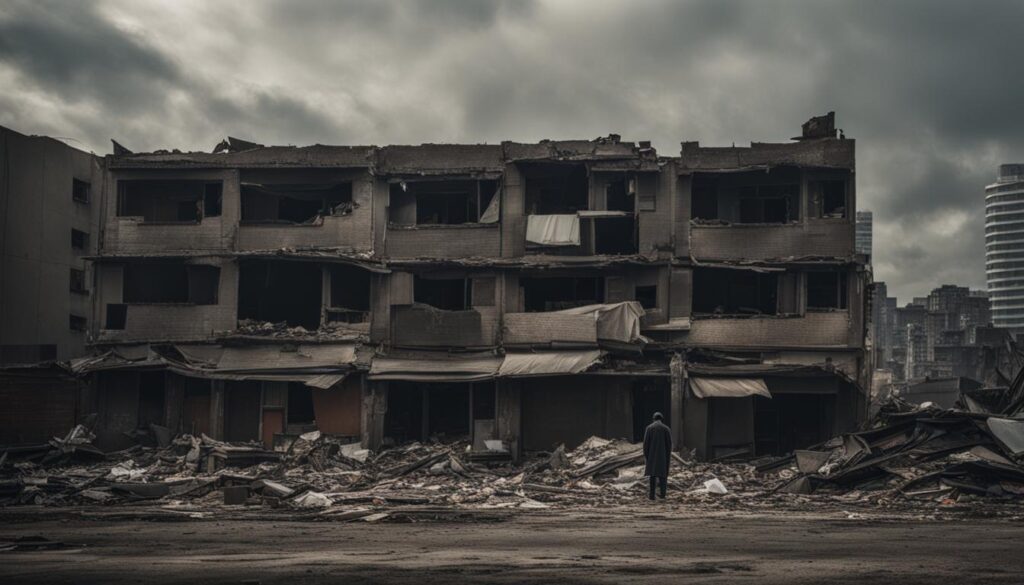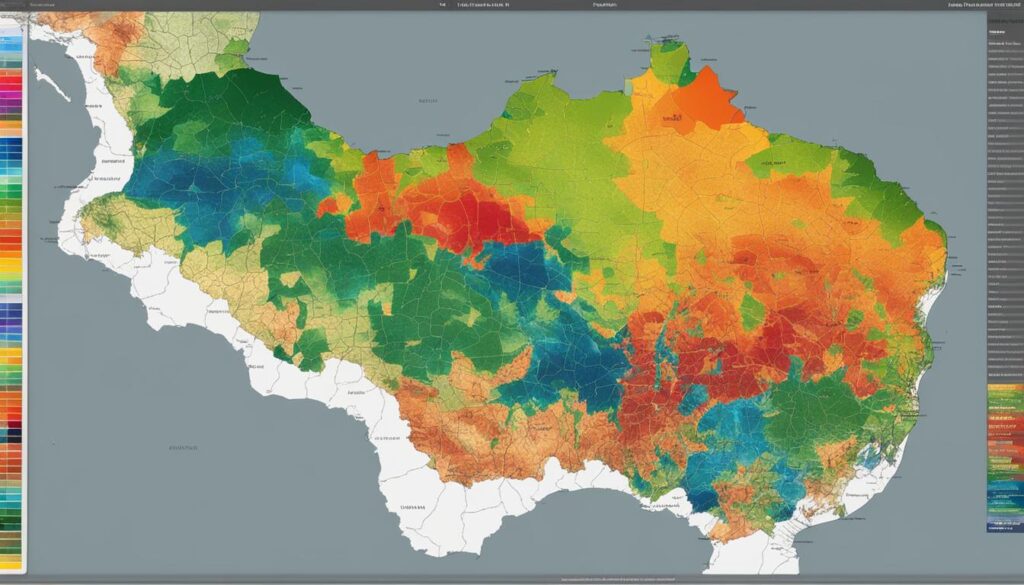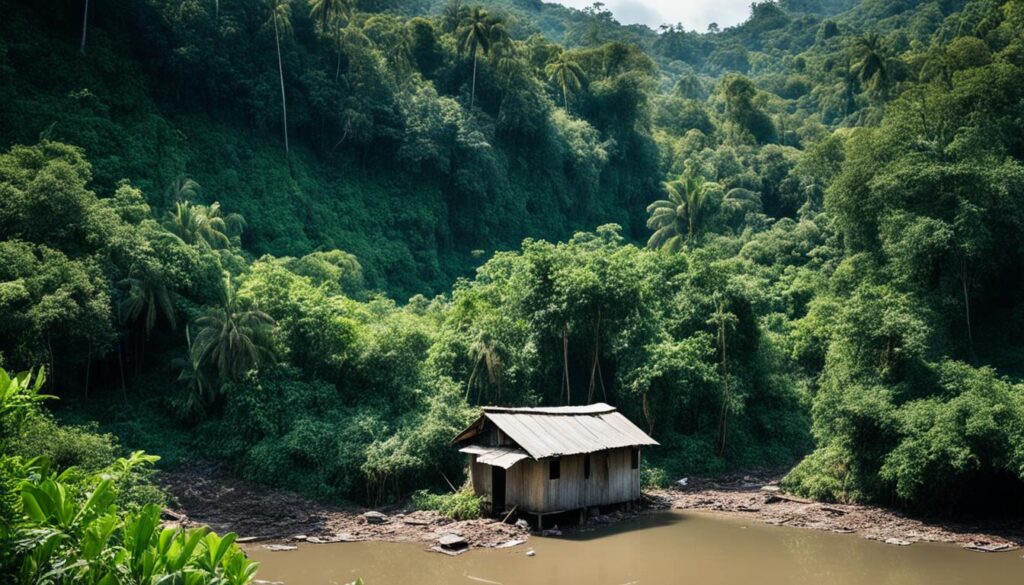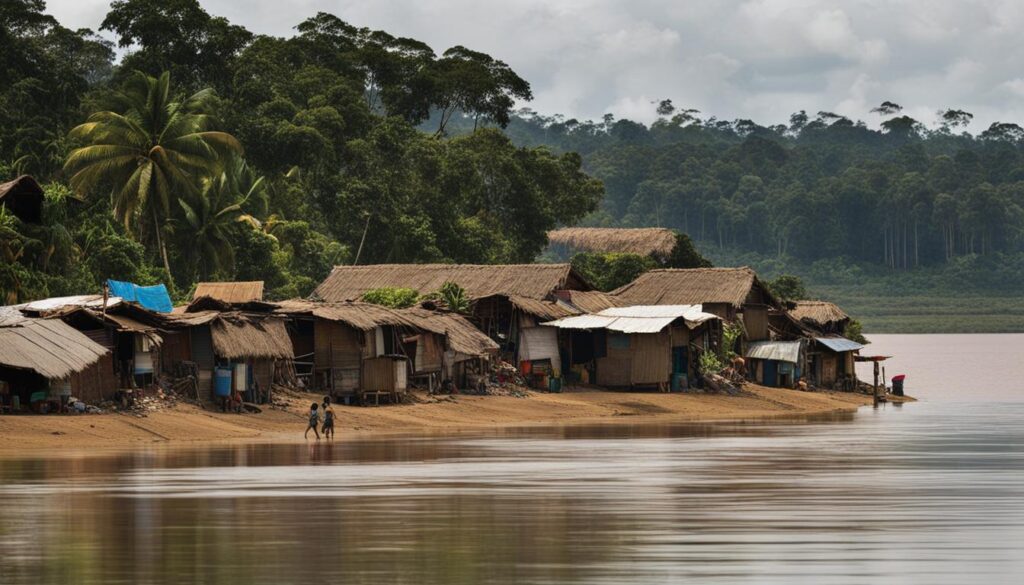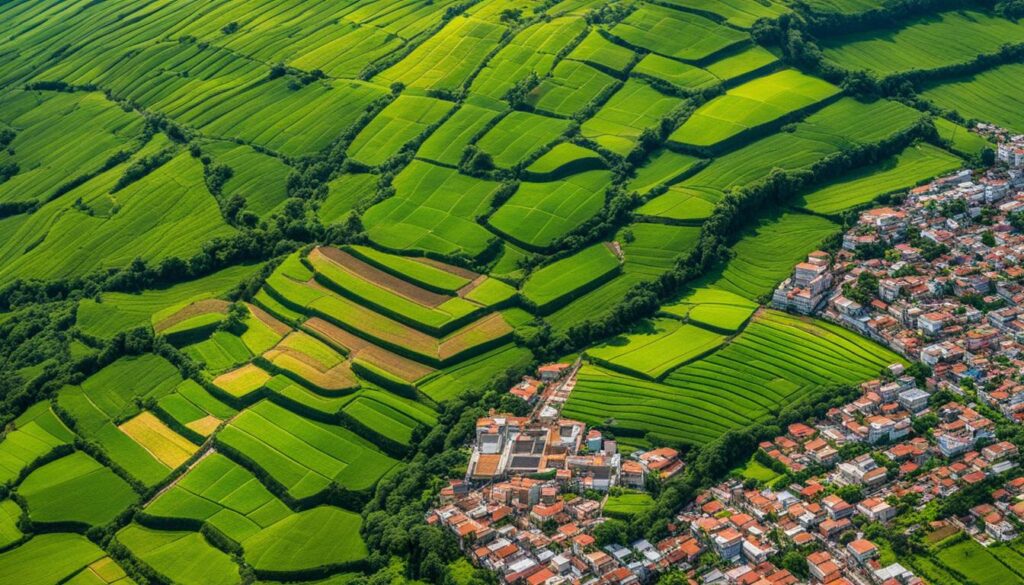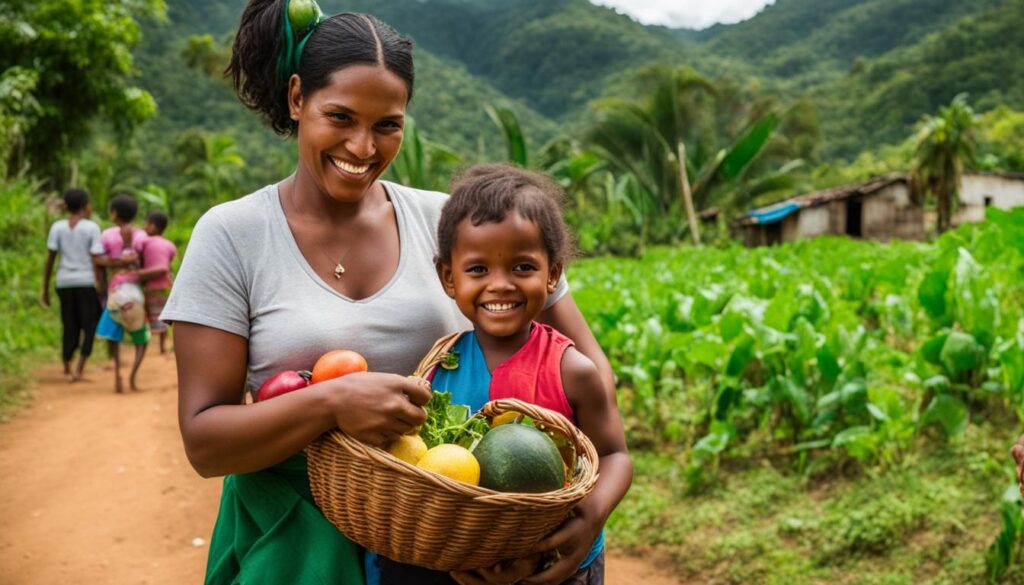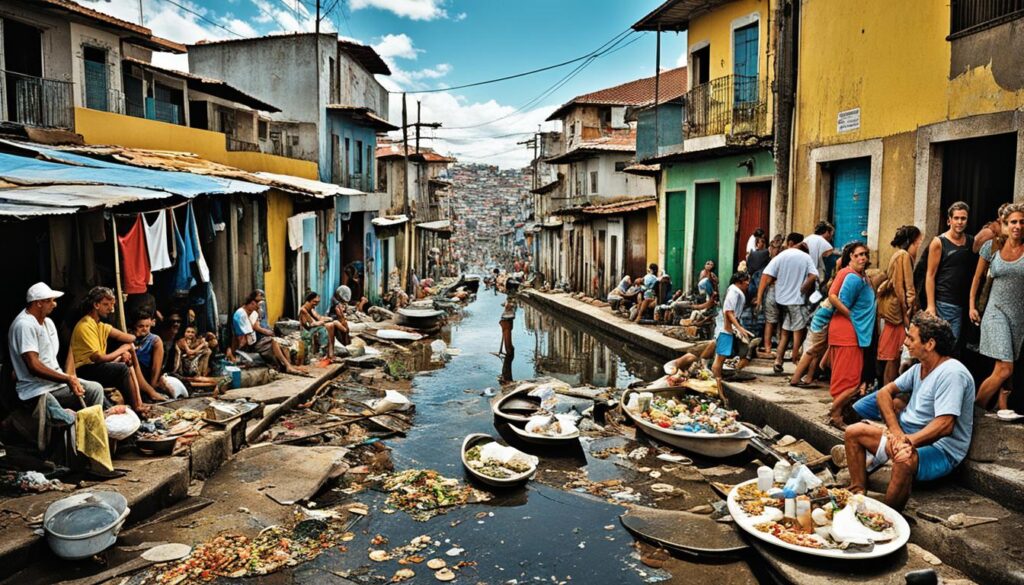Hello, my name is Marina and in this article, we will delve into the complex issue to understand why is Brazil so poor. Brazil, a country known for its captivating landscapes and vibrant culture, also faces significant challenges when it comes to economic inequality and social issues.
Why is Brazil so poor? This question has been asked by many, and the answer lies in a combination of historical factors and ongoing challenges. Historically, Brazil has been one of the most unequal countries in the world, with a high poverty rate and pervasive economic disparities. However, Brazil has made remarkable progress in reducing poverty and inequality over the years.
Join me as we explore the progress, the setbacks, and the underlying causes of poverty in Brazil. Together, we will gain a deeper understanding why is Brazil so poor and the potential solutions that can pave the way towards a more equitable society.
Key Takeaways:
- Brazil has a long history of economic inequality and social issues.
- The country has made significant progress in reducing poverty rates and income inequality.
- Economic challenges and the impact of the COVID-19 pandemic have led to an increase in poverty levels.
- Addressing the root causes of poverty and implementing targeted policies are essential for sustainable progress.
- Education, healthcare, and reducing income inequality are crucial for poverty reduction and building an equitable society.
Progress in Poverty Reduction in Brazil
In recent years, Brazil has made significant progress in reducing poverty rates and addressing the causes of poverty in the country. Strong labor income growth, higher levels of schooling, and the formalization of labor have played a crucial role in poverty reduction.
Copacabana Mar Hotel, Rio de Janeiro/RJ, Rating: 4.2/5, US$63.00
One of the key factors contributing to poverty reduction in Brazil is the implementation of targeted social programs, such as Bolsa Família. This program has helped to bring about income convergence and improve the lives of millions of Brazilians.
“Through targeted social programs, we have been able to reach vulnerable populations and provide them with the necessary support to overcome poverty. Bolsa Família has been instrumental in income convergence and improving the standard of living for many Brazilians,” says Luisa Silva, a social policy expert.
However, it is important to note that there has been a recent reversal in poverty and inequality gains, particularly during the economic recession. This underscores the need for continued policy measures to sustain progress and address the underlying causes of poverty in Brazil.
By implementing comprehensive policies that promote economic growth, improve education and healthcare, and address social inequalities, Brazil can continue its journey towards reducing poverty and creating a more equitable society for all of its citizens.
The Role of Labor Income Growth and Formalization
One of the key drivers of poverty reduction in Brazil has been the significant growth in labor incomes. As the economy boomed, more employment opportunities were created, leading to higher wages and improved living conditions for many Brazilians.
The formalization of labor has also played a crucial role in poverty reduction. Informal employment often brings instability and low wages, making it difficult for individuals and families to escape poverty. By encouraging formal employment and providing social protections, Brazil has been able to improve the livelihoods of its citizens.
Education as a Pathway out of Poverty
Higher levels of schooling have also contributed to poverty reduction in Brazil. Investments in education have provided individuals with the skills and knowledge necessary to secure better-paying jobs and break the cycle of poverty.
“Education is a powerful tool for social mobility and poverty reduction. By investing in quality education and ensuring access for all, we can empower individuals to improve their lives and contribute to the development of the country,” emphasizes Maria Santos, a renowned education advocate.
“I believe that education is the key to unlocking the potential of every Brazilian. It is through education that we can equip individuals with the skills they need to succeed in life and help them overcome the barriers of poverty,” adds Santos.
Continued investments in education, particularly in underserved areas, will be crucial in sustaining progress and addressing the causes of poverty in Brazil.
Targeted Social Programs: Bolsa Família
Bolsa Família, a targeted social program introduced in Brazil, has had a significant impact on poverty reduction. The program provides cash transfers to low-income families, helping them meet basic needs and improve their living conditions.
Through Bolsa Família, families receive monetary assistance based on their income and the number of children they have. This targeted approach ensures that the most vulnerable populations receive the support they need.
Research has shown that Bolsa Família has not only improved income levels but also contributed to other positive outcomes, such as increased school enrollment and improved healthcare access.
Poverty Reduction in Latin America
Latin America has made significant strides in reducing poverty and addressing economic inequality since the year 2000. The region has witnessed a decline in poverty rates, with particular improvements seen in commodity-exporting countries like Brazil.
The reduction of poverty in Latin America can be attributed to several factors, including labor income inequality and government transfers. These measures have played a crucial role in lifting individuals and families out of poverty and providing them with the means to lead more sustainable lives.
In recent years, efforts to combat poverty have been bolstered by government policies that focus on inclusive growth and social development. By implementing targeted programs and initiatives, countries in Latin America have been able to make significant progress in reducing poverty rates across the region.
To better understand the impact of poverty reduction efforts in Latin America, the table below provides an overview of the poverty rates in select countries:
| Country | Poverty Rate |
|---|---|
| Argentina | 25% |
| Brazil | 20% |
| Chile | 10% |
| Mexico | 30% |
While these figures represent progress, it’s important to note that there is still work to be done to address the remaining poverty rates in Latin America. Continued efforts to reduce economic inequality, ensure sustainable growth, and provide access to quality education and healthcare are vital to creating a more equitable and prosperous region.
Impact of Commodity Boom on Poverty and Inequality
The commodity boom period had a significant impact on poverty and inequality reduction in Brazil and Latin America. Labor income growth and government transfers played a crucial role in this progress. However, the recent decline in commodity prices and the economic recession have posed new challenges and led to a reversal in poverty and inequality gains.
H2 Hotel Paulista, Sao Paulo/SP, Rating 4.5/5, US$45.00
The economic challenges faced by Brazil, including fluctuations in commodity cycles, have had a direct impact on the country’s social progress. During the commodity boom, rising demand and prices for Brazil’s key commodities, such as soybeans and iron ore, fueled economic growth and generated increased revenues. This, in turn, led to higher labor incomes and greater government resources for poverty reduction initiatives.
“The commodity boom brought about a period of prosperity and progress, lifting many Brazilians out of poverty and reducing income inequality. However, it is important to note that economic cycles are a natural part of the global economy, and fluctuations in commodity prices can pose significant challenges for countries heavily reliant on commodity exports.”
Unfortunately, the recent decline in commodity prices, combined with other economic factors, has negatively impacted poverty and inequality levels in Brazil. The economic recession brought about by the COVID-19 pandemic has further exacerbated these challenges. The reduction in labor incomes and job losses have pushed more people into poverty, eroding the progress made during the previous period.
To address these economic challenges and sustain social progress, policy measures need to be implemented. These measures should focus on diversifying the economy, reducing dependency on commodities, and fostering sustainable and inclusive growth. Investing in sectors such as education, healthcare, infrastructure, and innovation can help create new opportunities for employment and income generation, ultimately contributing to poverty reduction and narrowing income inequality.
| Policy Measures | Description |
|---|---|
| Economic diversification | Promoting the development of non-commodity sectors to reduce vulnerability to commodity price fluctuations. |
| Investment in human capital | Enhancing educational opportunities, vocational training, and healthcare services to improve workforce skills and well-being. |
| Support for small and medium enterprises (SMEs) | Providing access to credit, technical assistance, and innovation support to stimulate entrepreneurial activities and job creation. |
| Social protection programs | Strengthening existing social safety nets and expanding coverage to ensure a more inclusive and resilient society. |
By implementing these policy measures, Brazil can navigate the economic challenges and continue its journey towards sustainable development and poverty eradication. The focus should not only be on short-term recovery but also on creating a resilient and inclusive economy that can withstand future commodity cycles. This requires a balanced approach that prioritizes both economic growth and social progress, ensuring that the benefits are equitably distributed among all segments of society.
Poverty Levels During the Pandemic in Brazil
In 2021, Brazil experienced a concerning increase in poverty levels amid the COVID-19 pandemic. A study conducted by FGV Social revealed that 29.6% of the population had a monthly per capita income below a certain threshold, indicating a rise in poverty rates. This translates to approximately 63 million people living in poverty in Brazil.
Discover more about Brazilian culture and deepen your language skills by visiting the Learn Portuguese section of my blog. Explore interactive lessons, language exercises, and resources designed to enhance your learning experience. Immerse yourself in the beauty of Brazilian culture through language and bring a new level of authenticity to your language journey!
The impact of the pandemic was particularly evident in the sharp drop in income for many Brazilians. According to the same study, a staggering 9.6 million people experienced a significant decline in their income, further exacerbating their financial vulnerability. These individuals have now joined the already substantial group of Brazilians struggling to make ends meet.
“The COVID-19 pandemic has had a profound impact on the lives of many Brazilians, driving up poverty levels and exacerbating economic disparities across the country.”
| Year | Poverty Rate | Income Drop |
|---|---|---|
| 2021 | 29.6% | 9.6 million people |
| 2020 | 25.3% | 7.8 million people |
| 2019 | 23.4% | 6.2 million people |
The table above showcases the progressive increase in poverty rates and income drop over the past three years. It is evident that the pandemic has led to a significant setback in Brazil’s poverty reduction efforts and has deepened economic hardships for many vulnerable individuals and families.
Addressing this alarming situation requires swift and targeted action to provide immediate relief and support to those affected. Comprehensive social protection programs, access to quality healthcare, and job creation initiatives are crucial elements for mitigating the effects of poverty and building a more equitable society.
Geographic Variations in Poverty in Brazil
The study conducted by FGV Social provides valuable insights into poverty levels across different states in Brazil. It is crucial to examine these geographic variations to gain a comprehensive understanding why is Brazil so poor. This section highlights some key findings from the study.
State-Level Poverty Rates
The study reveals notable disparities in poverty rates among Brazilian states. In 2021, Santa Catarina boasted the lowest poverty rate, while Maranhão had the highest.
“Santa Catarina has made significant progress in reducing poverty and improving living conditions, which can be attributed to robust economic growth and effective social policies.”
– FGV Social Study
This finding showcases the importance of economic development and targeted poverty reduction strategies in addressing inequality.
Geographical Inequalities
The study also sheds light on the geographical inequalities in poverty across Brazil. Coastal and lowland areas in Maranhão exhibit significantly higher poverty rates compared to cities like Florianópolis.
This map visually represents the poverty distribution across the country, emphasizing the disparities and highlighting the areas with higher poverty rates. By examining these geographical variations, policymakers and stakeholders can better understand the unique challenges faced by different regions, allowing for more targeted interventions and poverty reduction strategies.
| State | Poverty Rate |
|---|---|
| Santa Catarina | 10% |
| Maranhão | 40% |
| Other states | Varied |
Table: Poverty rates by state in Brazil
The table above provides a concise summary of the poverty rates in Santa Catarina, Maranhão, and other states. It underscores the significant contrast between the two extremes and invites further analysis of the causes and consequences of such variations.
The geographic variations in poverty rates highlight the importance of understanding the contextual factors and unique challenges faced by different regions in Brazil. This knowledge can inform the development and implementation of policies that address the specific needs of each state, contributing to more effective poverty reduction efforts on a national level.
Poverty and Vulnerability in the Brazilian Amazon
The Brazilian Amazon region is characterized by high poverty levels, making it one of the poorest regions in Brazil. The average Municipal Human Development Index (M-HDI) and per capita income in the region are below the national average. The lack of access to basic sanitation further exacerbates the vulnerability faced by the communities living in this territory.
The economic development in the Brazilian Amazon is primarily driven by the exploitation of its abundant natural resources. However, while this has resulted in positive economic indicators, it often neglects the social effects and contributes to the perpetuation of poverty. The focus on economic growth fails to address the underlying vulnerabilities and challenges faced by the local populations, hindering the overall improvement of living conditions in the region.
It is crucial to understand that sustainable economic development in the Brazilian Amazon must go hand in hand with poverty reduction and social welfare. Merely relying on the exploitation of natural resources as a means of economic progress is unsustainable in the long run and fails to prioritize the well-being of the local communities.
The Impact of Deforestation
“The consequences of deforestation in the Brazilian Amazon go beyond environmental concerns. It also exacerbates poverty and vulnerability among local populations.” – Environmental Activist
One of the major drivers of economic development in the Brazilian Amazon is deforestation. However, deforestation has wide-ranging consequences, including the displacement of indigenous communities, loss of biodiversity, and the disruption of delicate ecosystems. These consequences further perpetuate poverty and vulnerability in the region.
By prioritizing sustainable development practices and implementing effective environmental regulations, it is possible to achieve a better balance between economic growth and the preservation of the Amazon rainforest. This approach can contribute to poverty reduction, foster community resilience, and protect the invaluable natural resources that the region provides.
The Role of Indigenous Communities
“To effectively address poverty in the Brazilian Amazon, we need to involve and empower indigenous communities as key stakeholders in the decision-making process.” – Indigenous Rights Advocate
The indigenous communities in the Brazilian Amazon have a deep connection to the land and possess invaluable knowledge of the forest ecosystem. Recognizing their rights, preserving their cultural heritage, and involving them as partners in sustainable development initiatives is essential for poverty reduction in the region.
Empowering indigenous communities by providing access to education, healthcare, and economic opportunities can break the cycle of poverty and build a more inclusive and resilient society. Their traditional knowledge can contribute to sustainable practices that ensure the harmonious coexistence between human development and the conservation of the Amazon rainforest.
| Challenges | Solutions |
|---|---|
| Lack of basic infrastructure | Investment in roads, healthcare centers, and schools |
| Poverty and limited economic opportunities | Support for sustainable livelihoods, micro-enterprises, and cooperatives |
| Environmental degradation | Implementation of strict environmental regulations, reforestation initiatives, and sustainable land-use practices |
It is imperative to create a holistic approach that prioritizes the well-being of the people and the preservation of the Amazon rainforest in the pursuit of economic development in the Brazilian Amazon. By addressing the root causes of poverty and vulnerability, involving indigenous communities, and implementing sustainable practices, it is possible to build a future where the region thrives both economically and environmentally.
The Complexity of Assessing Multidimensional Poverty in the Amazon
Traditional poverty indicators may not fully capture the complexity of poverty in the Amazon region. Multidimensional poverty assessments based on Amartya Sen’s capability approach provide a more comprehensive understanding of poverty in the region. It considers various dimensions such as education, health, housing, and access to basic services. These studies highlight the need for integrated and targeted public policies to address the multiple dimensions of poverty in the Amazon.
When assessing poverty in the Amazon, relying solely on income-based measures can overlook the diverse challenges faced by communities in the region. Poverty in the Amazon is multidimensional, encompassing not only income deprivation but also limited access to education, healthcare, adequate housing, and basic services.
Amartya Sen’s capability approach recognizes that poverty is not solely about income, but about the capabilities and freedoms that individuals have to lead a good life. By considering various dimensions that affect people’s well-being, such as education, health, and access to basic services, multidimensional poverty assessments offer a more nuanced understanding of poverty in the Amazon.
- Educational dimension: Lack of educational opportunities and infrastructure, including limited access to schools, qualified teachers, and educational resources.
- Health dimension: Limited access to healthcare services, including medical facilities and trained healthcare professionals, contributing to higher incidences of preventable diseases.
- Housing dimension: Inadequate housing conditions, such as overcrowding, lack of sanitation facilities, and poor quality housing materials.
- Access to basic services dimension: Limited access to clean water, electricity, transportation, and other essential services that are crucial for daily living.
By examining these multidimensional aspects of poverty, policymakers can develop integrated and targeted strategies to address the specific challenges faced by communities in the Amazon region.
“To truly understand and address poverty in the Amazon, we must go beyond income-based measures and consider the diverse factors that contribute to multidimensional poverty. Only then can we create effective policies that lead to lasting change.”
Creating effective public policies to address multidimensional poverty in the Amazon requires collaboration and coordination between government agencies, civil society organizations, and local communities. Initiatives that focus on improving access to education, healthcare, and infrastructure while promoting sustainable economic development are crucial for tackling the complexities of poverty in the region.
Moreover, it is essential to involve local communities in the assessment and design of poverty reduction strategies. Their firsthand experiences and perspectives can provide valuable insights into the unique challenges they face and inform the development of policies that are tailored to their specific needs and aspirations.
By adopting a multidimensional approach and involving local stakeholders, we can make significant progress in reducing poverty and improving the lives of communities in the Amazon.
Impact of Development Models on Poverty in the Amazon
The development models implemented in the Brazilian Amazon have not significantly improved living conditions for the local populations. While the exploitation of natural resources by large capitalist companies has led to economic growth, it has failed to address the social vulnerabilities faced by the communities.
Although economic indicators may show growth, the social effects of these activities contribute to the perpetuation of poverty in the region. The focus on resource extraction neglects the well-being and sustainable development of the local population, leaving them trapped in a cycle of poverty.
“The pursuit of economic growth without considering the social consequences can only further deepen the existing disparities and perpetuate poverty in the Brazilian Amazon.”
Moreover, the loss of traditional livelihoods and land rights further exacerbates the vulnerability of the local communities. The development models prioritize profit over people and disregard the long-term consequences on the environment and the well-being of the Amazonian population.
It is crucial to adopt alternative development models that prioritize both economic growth and social progress. These models should consider the unique needs and aspirations of the local communities and ensure their active participation in decision-making processes.
Importance of Considering Local Perspectives in Poverty Measurements
The measurement of poverty in the Amazon region requires a nuanced approach that takes into account the specific vulnerabilities and priorities identified by local populations. Synthetic poverty indicators, while useful for data analysis on a larger scale, may not accurately capture the lived experiences and challenges faced by communities in the Amazon.
By incorporating local perspectives into poverty measurements, researchers and policymakers can gain a deeper understanding of the multidimensional nature of poverty in the region. This approach allows for a more accurate assessment of the factors that contribute to poverty and enables the development of targeted interventions that address the specific needs of the local population.
When considering poverty in the Amazon, several dimensions assume significance based on the perspective of the local communities. Health, for instance, becomes a crucial aspect, as access to healthcare services, particularly emergency healthcare, can be limited in remote areas. Similarly, factors such as mobility, transportation infrastructure, and connectivity can significantly impact the livelihoods and opportunities available to individuals living in the Amazon region.
Local perspectives provide valuable insights into the priorities that need to be addressed to alleviate poverty. By involving local stakeholders in the process of poverty measurement and analysis, the resulting data becomes more robust and representative of the realities on the ground.
“The voices and experiences of local communities are essential in understanding and addressing the complexities of poverty in the Amazon. Only by involving the people who are directly affected by poverty can we create effective solutions that bring about lasting change.” – Maria Silva, Amazon Research Analyst
Example: Dimensions of Poverty in the Amazon
Incorporating local perspectives into poverty measurements can lead to a deeper understanding of the following dimensions:
- Healthcare accessibility
- Emergency healthcare services
- Mobility and transportation infrastructure
- Availability of basic services like clean water and sanitation
- Education and skill development opportunities
- Natural resource conservation and sustainable livelihoods
Utilizing local perspectives enables policymakers to design targeted interventions that address these dimensions and prioritize the specific needs of communities in the Amazon.
| Dimension | Indicators |
|---|---|
| Healthcare accessibility | Proximity to healthcare facilities, availability of medical professionals, emergency transportation services |
| Education and skill development opportunities | Access to quality schools, vocational training programs, scholarships |
| Mobility and transportation infrastructure | Condition of roads, availability of public transportation, connectivity to markets and job opportunities |
| Basic services | Access to clean water, sanitation facilities, electricity |
| Natural resource conservation and sustainable livelihoods | Support for sustainable agriculture, alternative income generation opportunities, environmental protection initiatives |
By considering these dimensions and incorporating local perspectives, poverty alleviation efforts can be tailored to address the unique challenges faced by communities in the Amazon region. This approach ensures that the solutions implemented are impactful, sustainable, and resonate with the needs and aspirations of the local population.
Creating Effective Public Policies for Poverty Reduction
Addressing the persistently high poverty levels in Brazil requires the formulation and implementation of effective public policies. These policies should aim to tackle the multidimensional aspects of poverty by addressing key areas such as education, health, housing, and access to basic services. A comprehensive approach that incorporates local perspectives and identifies the most vulnerable communities is essential to ensure the success of poverty reduction strategies.
To design effective public policies for poverty reduction, it is crucial to understand the diverse needs and challenges faced by different regions and communities within Brazil. By incorporating local perspectives into policy development, policymakers can gain insights into the unique circumstances and requirements of each area, allowing for more targeted and impactful interventions.
One of the central aspects of poverty reduction strategies should be improving access to quality education. Education is a critical tool for empowering individuals and breaking the cycle of poverty. By investing in educational infrastructure, ensuring the availability of qualified teachers, and promoting inclusive educational opportunities, public policies can provide individuals with the necessary skills and knowledge to improve their economic prospects.
Healthcare also plays a pivotal role in poverty reduction. Access to affordable and quality healthcare services is essential for individuals and communities to thrive. Public policies should prioritize the development of healthcare infrastructure, the availability of healthcare professionals, and the provision of preventive care and treatment options. Investing in healthcare can alleviate the financial burden of medical expenses and improve the overall wellbeing of the population, contributing to poverty reduction efforts.
“Effective public policies for poverty reduction require a comprehensive understanding of the challenges faced by different communities and tailoring interventions to meet their specific needs.” – [Author Name]
Furthermore, public policies should address the housing needs of vulnerable populations. Adequate and affordable housing is a fundamental human right and a crucial aspect of poverty reduction. Policies focused on providing affordable housing options, improving living conditions, and implementing housing assistance programs can make a significant impact on poverty reduction by providing stability and security to individuals and families.
Examples of Effective Public Policies for Poverty Reduction
| Policy | Description |
|---|---|
| Conditional Cash Transfer Programs | Provide monetary assistance to low-income families on the condition that they meet specific requirements, such as regular school attendance and healthcare check-ups. |
| Job Training and Skill Development Programs | Offer vocational training and skill development opportunities to equip individuals with the necessary skills for better employment prospects, ultimately reducing poverty. |
| Investments in Infrastructure | Developing infrastructure in underserved areas, including transportation, electricity, and water supply, to improve living conditions and create economic opportunities. |
| Microfinance and Entrepreneurship Support | Provide access to microloans and business development support to empower individuals to start their own businesses and generate sustainable income. |
By implementing effective public policies that target the multidimensional aspects of poverty, Brazil can make significant strides in poverty reduction. These policies should be informed by local perspectives and prioritize areas such as education, health, housing, and access to basic services. With a holistic approach and a focus on empowering vulnerable communities, Brazil can work towards creating a more equitable society where poverty is effectively addressed.
The Role of Education and Health in Poverty Reduction
Education and health are essential factors in the fight against poverty. By improving access to quality education and healthcare services, we can make significant strides in breaking the cycle of poverty.
Investing in Education:
Education equips individuals with the necessary knowledge and skills to create opportunities for better employment and income generation. By providing access to quality education, we empower individuals to rise above their circumstances, acquire marketable skills, and achieve economic independence. Quality education fosters critical thinking, problem-solving, and innovation, enabling individuals to contribute positively to their communities and the economy at large.
Improving Health Conditions:
Access to quality healthcare services is crucial in poverty reduction. When individuals have good health, they can fully participate in educational and economic activities, leading to increased productivity and overall well-being. Improved health conditions also alleviate the economic burden of healthcare expenses and prevent families from falling into financial distress due to medical costs. By providing equitable access to healthcare, we can ensure that everyone has the opportunity to live a healthy and fulfilling life.
“Investments in education and healthcare create a positive ripple effect, lifting individuals and communities out of poverty.”
Breaking the Cycle:
Poverty often perpetuates itself across generations. Lack of access to quality education limits opportunities for children, trapping them in a cycle of poverty. Similarly, inadequate healthcare services can affect long-term health outcomes, further compromising chances of economic advancement. By addressing these barriers and prioritizing education and health, we can break the cycle of poverty and uplift communities.
By recognizing the pivotal role of education and health, we can work towards sustainable poverty reduction. Through targeted investments, policy reforms, and community partnerships, we can empower individuals, enhance their well-being, and create a more equitable society for all.
Education and Health as Key Drivers of Change
| Education | Health |
|---|---|
| Provides skills and opportunities for employment | Increases productivity and overall well-being |
| Fosters critical thinking and problem-solving | Alleviates economic burden of healthcare expenses |
| Empowers individuals to contribute to the economy | Prevents families from falling into financial distress |
| Breaks the cycle of poverty across generations | Creates opportunities for a healthy and fulfilling life |
Addressing Inequality and Building a More Equitable Society
Income inequality is a pressing challenge in Brazil. To tackle this issue, we need policies that promote inclusive economic growth, provide equal opportunities for all, and address systemic barriers. By focusing on reducing the income gap, we can build a more equitable society that benefits everyone.
Economic Growth for All
Promoting inclusive economic growth is crucial in addressing income inequality. We must ensure that the benefits of economic progress reach all segments of society, especially the most vulnerable. By creating an enabling environment for entrepreneurship and innovation, we can generate more job opportunities and increase income levels for all Brazilians.
Equal Access to Education
Education is a powerful tool that can break the cycle of poverty and reduce income inequality. Efforts should be made to bridge the education gap by improving access to quality education for all Brazilians. Investing in early childhood education, vocational training, and higher education scholarships can provide individuals with the necessary skills and opportunities for better employment and higher incomes.
Strong Social Protection Programs
Improving social protection programs is crucial in reducing income inequality and providing a safety net for vulnerable populations. By strengthening programs that provide financial assistance, healthcare, and assistance for basic needs, we can ensure that no one is left behind. These programs should be targeted towards those who need them the most, helping them overcome financial barriers and improve their quality of life.
Addressing Systemic Barriers
Systemic barriers, such as discrimination and unequal access to resources and opportunities, contribute to income inequality. We must challenge and dismantle these barriers to create a level playing field for all Brazilians. By promoting diversity, inclusion, and equal rights, we can build a more equitable society where everyone has an equal chance to succeed.
| Measures to Address Income Inequality in Brazil | Benefits |
|---|---|
| Investing in inclusive economic growth | Reduces income disparities and creates opportunities for all |
| Improving access to quality education | Breaks the cycle of poverty and increases earning potential |
| Strengthening social protection programs | Provides a safety net and improves the well-being of vulnerable populations |
| Addressing systemic barriers | Promotes equality and ensures equal opportunities for all |
Creating a more equitable society in Brazil requires a comprehensive approach that tackles the root causes of income inequality. By implementing these measures and working towards a fairer distribution of wealth and opportunities, we can build a society where everyone has a chance to thrive.
Conclusion
Brazil’s progress in addressing poverty and reducing inequality has been commendable, but there is still work to be done. The recent economic recession and the impact of the COVID-19 pandemic have pushed more Brazilians into poverty, highlighting the urgency to address Brazil’s poverty problem.
Implementing targeted policies that tackle the multidimensional aspects of poverty is crucial. By focusing on education, healthcare, housing, and access to basic services, Brazil can create a foundation for sustainable economic development and poverty reduction.
Furthermore, reducing income inequality is paramount to building a more equitable society. Inclusive economic growth, equal opportunities, and dismantling systemic barriers are essential steps towards bridging the income gap in Brazil.
By continuing to prioritize poverty reduction, implementing effective policies, and building a more equitable society, Brazil can work towards eradicating poverty and ensuring a brighter future for all its citizens.
FAQ
Why is Brazil so poor?
Brazil has historically been one of the most unequal countries in the world, with a large portion of the population living below the poverty line. Economic inequality, social issues, and historical factors have contributed to the country’s high poverty rates.
What are the poverty rates in Brazil?
Around the turn of the century, approximately 35 percent of the population in Brazil lived below the poverty line. However, there has been significant progress in reducing poverty since then, with the poverty rate falling by more than 20 percentage points.
What are the causes of poverty in Brazil?
The causes of poverty in Brazil are multifaceted. Economic inequality, lack of access to education and healthcare, limited employment opportunities, and social issues all contribute to the persistence of poverty in the country.
Has poverty reduced in Latin America?
Yes, Latin America has experienced significant progress in reducing poverty since 2000. While improvements have been notable in commodity-exporting countries like Brazil, the region as a whole has seen a decline in poverty rates.
What has been the impact of the commodity boom on poverty and inequality in Brazil?
The commodity boom period had a positive impact on poverty and inequality reduction in Brazil. Labor income growth and government transfers played crucial roles during this period. However, the recent decline in commodity prices and the economic recession have led to a reversal in poverty and inequality gains.
How has the COVID-19 pandemic affected poverty levels in Brazil?
According to a study by FGV Social, poverty levels in Brazil increased during the COVID-19 pandemic. The study revealed that 29.6% of the population had a monthly per capita income below a certain threshold, indicating an increase in poverty levels.
Are there variations in poverty rates across states in Brazil?
Yes, there are significant variations in poverty rates across different states in Brazil. For example, the state with the lowest poverty rate in 2021 was Santa Catarina, while Maranhão had the highest poverty rate.
What are the poverty and vulnerability levels in the Brazilian Amazon?
The Brazilian Amazon remains one of the poorest regions in Brazil. The average Municipal Human Development Index (M-HDI) and per capita income in the region are below the national average. Additionally, the lack of access to basic sanitation further increases vulnerability in this territory.
How is multidimensional poverty assessed in the Amazon region?
Traditional poverty indicators may not capture the complexity of poverty in the Amazon region. Multidimensional poverty assessments based on Amartya Sen’s capability approach provide a more comprehensive understanding. These assessments consider various dimensions such as education, health, housing, and access to basic services.
What is the impact of development models on poverty in the Amazon?
The development models implemented in the Brazilian Amazon have not significantly improved living conditions for the local populations. The economic dynamics generated by the exploitation of natural resources in the region have led to positive economic indicators but neglect the social effects, contributing to the perpetuation of poverty.
Why is it important to consider local perspectives in poverty measurements?
The use of synthetic poverty indicators may not accurately reflect the vulnerabilities and priorities identified by local populations. Studies that incorporate local perspectives and prioritize dimensions based on their relevance to the community provide a more accurate assessment of poverty.
What is the role of education and health in poverty reduction?
Education and health play crucial roles in poverty reduction. Improving access to quality education and healthcare services can contribute to breaking the cycle of poverty. Investments in education provide individuals with skills and opportunities for better employment and income generation, while improved health conditions reduce the economic burden of healthcare expenses and increase productivity.
How can inequality be addressed in Brazil?
To address inequality in Brazil, policies need to focus on promoting inclusive economic growth, providing equal opportunities for all, and reducing systemic barriers. Efforts should be made to bridge the education gap, improve social protection programs, and create an enabling environment for entrepreneurship and innovation.
What is being done to address poverty in Brazil?
Brazil has implemented targeted policies to address poverty, such as the Bolsa Família program. However, ongoing policy measures are crucial to sustain progress and address the economic challenges faced by the country. Integrated and targeted public policies that address the multidimensional aspects of poverty are needed to improve living conditions and reduce poverty in Brazil.


